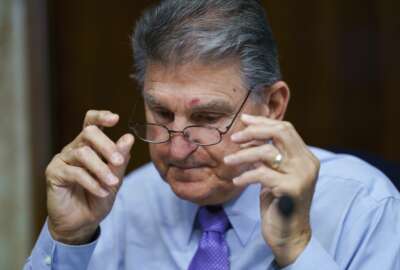
Federal contractor forecast: Cloudy with a chance of needles
For contractors and feds alike, the waiting for final COVID rules and protocols is as bad as what the rules might be.
An old expression, “roll up your sleeves and get to work,” has new meaning in the age of pandemic.
The big difference with the federal employee vaccine mandate is, most people are used to having, and expect to have, things taken out of their bodies. Breath tests in case you’re pulled over. Urine samples for drug testing. Often the giveaways are voluntary. Blood draws for medical panels or donation. Spit for DNA. Some people clip their long hair and donate it to cover the head of a child cancer patient whose hair has fallen out.
But being forced to take something into one’s bloodstream at peril of losing your job, that is new territory. No amount of debate will settle this question. As someone who got vaccinated last March, I understand the passion on both sides of the argument, if fully accepting neither.
The pandemic has quickly soured from a shared horror, to a weird cultural divide. We’ve got those who revel maskless at super-spreader concerts or rallies, and those who still irradiate their Grape-Nuts when returning from the grocery store, after driving home with a mask on in the car. Just look at the wide variances in how state governors approach what’s going on. Now nearly everyone is a Hatfield or a McCoy. I’ve noticed, this divide doesn’t cut across the lines — such as ethnic, geographical, political or educational — that typically divide people, but rather from something deeper within individuals.
Published reports have it that President Joe Biden will meet with some large corporate CEOs to get them on board with mandatory vaccines. Many companies already have. So federal employees have lots of company as they await detailed guidance on how agencies will carry out the vaccine mandate.
That company logically extends to the federal contractors who ordinarily work on site at your agency. Contractors have been part of the return planning at least since January, when a White House executive order established the forcefully named Safer Federal Workforce Task Force. It’s a big committee of federal executives, each of whom designates some poor career schlimazel to do the actual head-scratching, twisting-in-chair work. The kind of work that no matter what you come up with someone will hate it.
The work is not merely emotional, it’s downright complicated. Contractor COVID policy could end up varying from agency to agency. You can understand why contractors are on edge.
The White House didn’t name contractors specifically in the September 9 employees mandate, but it did include “individuals interacting with the federal workforce.” Not to worry, the second September 9 memo devoted much detail to contractors, but fell just short of a vaccine mandate.
If the administration imposes a mandate, it will have an analog to the needle which delivers the vaccine. Namely, a new rule in the Federal Acquisition Regulation, and presumably in the Defense supplement, requiring contractors to comply with whatever ends up being the final COVID mandates. That is, if they want to keep getting federal contracts. The requirements will extend to subcontractors, too.
That rulemaking takes place in October, and contractor lawyers have urged clients to send in comments. That’s what Amy Conway, a partner at the Stinson law firm, confirmed. She said her clients are all nervously waiting to see what happens. Holland and Knight Partner Eric Crusius said the same thing. Both said that for the companies they represent, uncertainty presents their biggest worry.
At this point no one knows how the mandates will shape up, precisely. Don’t forget, the Task Force’s concerns go beyond vaccines and mask wearing. They also include cleaning, hygiene, office occupancy density, ventilation, symptom monitoring and contact tracing, how to handle meetings and conferences, travel, and of course testing. Read about them all in this just-out “safety principles model.”
In some federal locations, contractors outnumber federal employees. What do occupancy and hygiene models in those situations look like?
Another bifurcation cuts between the big, traded contractors and the hundreds of thousands of small businesses that do government work. When I asked, Conway confirmed that the biggies can more easily impose employee vaccine mandates of their own than small companies can. Small companies can less afford to have people walk over such a mandate. They might be located in areas where more people opposed the vaccine or don’t want it for themselves.
When it comes to the vaccine, people fall into three basic buckets. The “sure, no problem” people, the “I’m suspicious but here’s my shoulder,” and the “no way I’m letting that poison in me.” No policy can accommodate everyone, and at some point the government will have to establish its policy and let the chips fall. Whatever it’ll be, I think rank-and-file federal employees and contractors would both like to see it already.
Nearly Useless Factoid
The novel Catch-22 was rejected by publishers 22 times.
Source: Literary Hub
Copyright © 2024 Federal News Network. All rights reserved. This website is not intended for users located within the European Economic Area.
Tom Temin is host of the Federal Drive and has been providing insight on federal technology and management issues for more than 30 years.
Follow @tteminWFED





